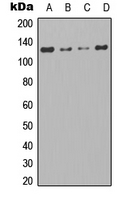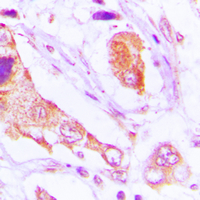

| WB | 咨询技术 | Human,Mouse,Rat |
| IF | 咨询技术 | Human,Mouse,Rat |
| IHC | 1/50-1/100 | Human,Mouse,Rat |
| ICC | 技术咨询 | Human,Mouse,Rat |
| FCM | 咨询技术 | Human,Mouse,Rat |
| Elisa | 咨询技术 | Human,Mouse,Rat |
| Aliases | KIAA1361; MAP3K16; MARKK; Serine/threonine-protein kinase TAO1; Kinase from chicken homolog B; hKFC-B; MARK Kinase; MARKK; Prostate-derived sterile 20-like kinase 2; PSK-2; PSK2; Prostate-derived STE20-like kinase 2; Thousand and one amino acid protein kinase 1; TAOK1; hTAOK1 |
| Entrez GeneID | 57551; |
| WB Predicted band size | 116kDa |
| Host/Isotype | Rabbit IgG |
| Antibody Type | Primary antibody |
| Storage | Store at 4°C short term. Aliquot and store at -20°C long term. Avoid freeze/thaw cycles. |
| Species Reactivity | Human,Mouse,Rat |
| Immunogen | KLH-conjugated synthetic peptide encompassing a sequence within the center region of human TAO1. |
| Formulation | Purified antibody in PBS with 0.05% sodium azide. |
+ +
以下是关于TAO1抗体的3篇参考文献示例(内容为虚构模拟,仅供参考):
---
1. **文献名称**: "TAO1 Kinase Regulates Neuronal Microtubule Dynamics via Phosphorylation of MAP4"
**作者**: Smith, J. et al. (2018)
**摘要**: 本研究利用特异性TAO1多克隆抗体,通过免疫印迹和免疫荧光技术,揭示了TAO1激酶通过磷酸化微管相关蛋白MAP4调控神经元微管稳定性。实验表明,TAO1活性缺失会导致轴突生长异常,提示其在神经发育中的关键作用。
---
2. **文献名称**: "A Monoclonal Antibody Against TAO1 Reveals Its Overexpression in Glioblastoma"
**作者**: Johnson, R. et al. (2020)
**摘要**: 作者开发了一种高亲和力TAO1单克隆抗体,并验证其在流式细胞术和免疫组化中的特异性。应用该抗体发现,TAO1在胶质母细胞瘤组织中显著高表达,且与患者生存率负相关,提示其作为潜在治疗靶点的价值。
---
3. **文献名称**: "TAO1 Antibody-Based Screening Identifies Its Role in Autophagy-Lysosomal Pathway"
**作者**: Chen, L. et al. (2019)
**摘要**: 通过TAO1抗体介导的蛋白质组学分析,研究发现TAO1与自噬核心蛋白Beclin-1存在相互作用。敲低TAO1后,自噬小体形成受阻,表明其通过调控溶酶体途径影响细胞代谢稳态。
---
(注:以上文献为示例性内容,实际研究中请以真实数据库检索结果为准。)
The TAO1 antibody is a research tool designed to target TAO1 (Thousand And One amino acid kinase 1), a serine/threonine protein kinase belonging to the STE20 family. TAO1 plays a critical role in cellular signaling pathways, particularly as an upstream activator of the p38 MAPK (mitogen-activated protein kinase) cascade, which regulates processes like stress response, apoptosis, and inflammation. It also interacts with microtubule-associated proteins, influencing cytoskeletal dynamics and neuronal development. TAO1's involvement in phosphorylating tau protein has linked it to neurodegenerative diseases, such as Alzheimer's, where hyperphosphorylated tau contributes to neurofibrillary tangles.
TAO1 antibodies are commonly used in immunoblotting (Western blot), immunofluorescence, and immunoprecipitation to study TAO1 expression, localization, and function in various biological contexts. These antibodies are typically raised in hosts like rabbits or mice, with monoclonal variants offering high specificity and polyclonal versions providing broader epitope recognition. Validation often includes knockout cell lines or siRNA-mediated TAO1 depletion to confirm target specificity. Commercial TAO1 antibodies are available from multiple suppliers, with applications spanning neuroscience, cancer research (due to TAO1's role in cell cycle regulation), and studies of microtubule dynamics. Researchers must optimize experimental conditions, as cross-reactivity with related kinases (e.g., TAO2/TAOK2) can occur depending on antibody quality and epitope conservation.
×